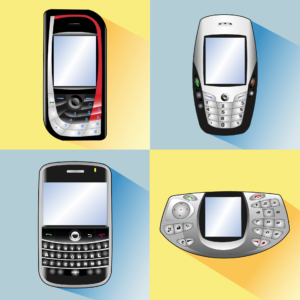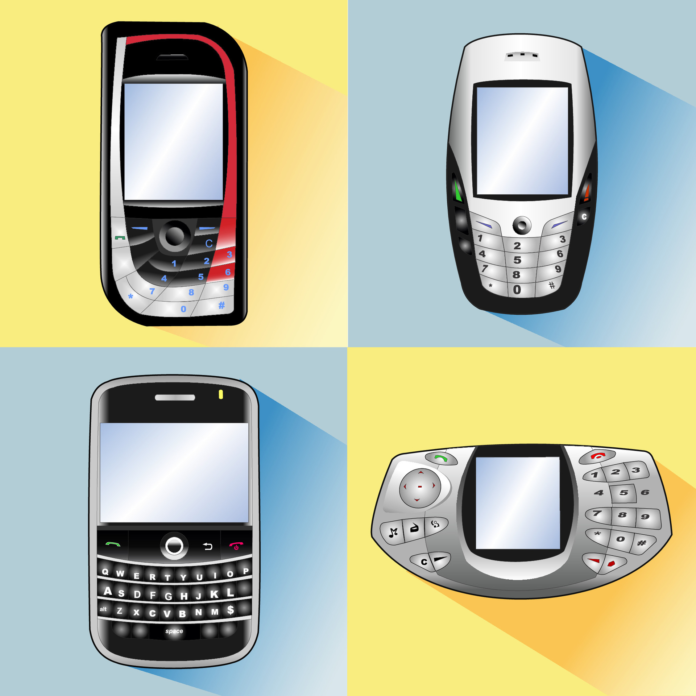In the ever-evolving landscape of mobile technology, we’ve witnessed groundbreaking innovations and remarkable leaps forward. However, for every success story, there are bound to be some missteps. In this blog, we’ll take a nostalgic tour through the annals of phone history to explore the top 10 worst phones of all time.

Contents
1. Nokia N-Gage (2003)
The Nokia N-Gage, released in 2003, holds a dubious distinction in the history of mobile phones. Marketed as a hybrid gaming console and phone, it was a bold attempt to merge two popular forms of entertainment. However, it quickly became apparent that this ambitious endeavor was fraught with shortcomings.
One of the most glaring issues was its ergonomics. The N-Gage was an oddity in terms of design, resembling a taco more than a phone. Holding it up to one’s ear for a conversation felt awkward, leading to the device being mockingly referred to as a “sidetalker.” This design flaw, coupled with the necessity to remove the battery to change games, made for a cumbersome user experience.
Moreover, the game library, a critical component for a gaming-centric device, was limited and struggled to compete with dedicated handheld consoles like the Nintendo Game Boy Advance. This left gamers underwhelmed and searching for better alternatives.
Despite these missteps, it’s important to acknowledge that the Nokia N-Gage did bring some innovative features to the table. It incorporated Bluetooth connectivity, allowing for multiplayer gaming—a novel concept at the time. Additionally, it introduced the idea of online gaming communities, a precursor to modern multiplayer gaming networks.
Regrettably, the N-Gage’s innovative features couldn’t overcome its fundamental design flaws and lackluster game selection. The device ultimately failed to gain traction in a market where specialized gaming devices and dedicated mobile phones were already well-established.
In retrospect, the Nokia N-Gage serves as a cautionary tale for manufacturers looking to merge disparate technologies. It highlights the importance of seamless integration, user-friendly design, and a robust app ecosystem. While it may have fallen short of its ambitious goals, it remains a unique piece of mobile tech history, showcasing the industry’s continuous quest for innovation—even if not every attempt hits the mark.
2. Motorola ROKR E1 (2005)
Developed in collaboration with Apple, the ROKR E1 was intended to be the first phone to support iTunes. However, its limited song capacity, sluggish software, and uninspired design left consumers disappointed. It failed to capture the imagination of music enthusiasts and was soon overshadowed by the iconic iPod.
3. Samsung Galaxy Note 7 (2016)
Ah, the Samsung Galaxy Note 7. This particular entry on our list is one that left a significant mark on the smartphone industry, but not for the right reasons. Released in 2016, the Galaxy Note 7 was highly anticipated, thanks to its impressive hardware and innovative features. It was positioned to be a game-changer in the phablet market.
However, what should have been a triumph for Samsung quickly turned into a catastrophic failure. Reports began to surface of the device overheating, and in some cases, even catching fire or exploding. The source of this issue was traced back to a critical flaw in the battery design.
Samsung responded swiftly, issuing a recall and replacement program. Unfortunately, the replacement units were plagued by the same problems, prompting a second recall. The fallout from this debacle was immense. Airlines banned the device from flights, and the U.S. government officially recalled all Galaxy Note 7s.
The financial impact was staggering, costing Samsung billions of dollars in losses. More importantly, it dealt a severe blow to the company’s reputation. Consumers who once trusted the brand were now hesitant, and competitors were quick to capitalize on Samsung’s misfortune.
This incident served as a sobering reminder of the critical importance of rigorous quality control, particularly when it comes to a device that is carried around by millions of people every day. It also highlighted the potential dangers of rushing a product to market without thorough testing.
In the aftermath of the Galaxy Note 7, Samsung implemented extensive battery safety measures and testing procedures to prevent a recurrence of such a debacle. While the incident was undoubtedly a black mark in Samsung’s history, it also demonstrated the company’s commitment to rectifying mistakes and ensuring the safety of its customers.
In the end, the Galaxy Note 7 serves as a cautionary tale for the entire industry, emphasizing the need for stringent quality assurance processes, even in the race to introduce cutting-edge technology. It’s a chapter that Samsung, and the smartphone world as a whole, won’t soon forget.
4. Amazon Fire Phone (2014)
In 2014, Amazon, a global powerhouse in e-commerce and cloud services, ventured into the highly competitive smartphone market with the release of the Fire Phone. Hyped as a potential game-changer, the device fell short of expectations and ultimately became a cautionary tale in the world of tech.
The Vision
Amazon’s Fire Phone was born from a grand vision: to seamlessly integrate the vast Amazon ecosystem into a handheld device. With features like Firefly, which allowed users to scan objects and get instant purchase options on Amazon, and Dynamic Perspective, a 3D-like display effect, the Fire Phone aimed to offer an immersive shopping and entertainment experience.
The Missteps
- Limited App Ecosystem: Unlike its Android and iOS counterparts, the Fire Phone ran on a heavily customized version of Android that lacked access to the Google Play Store. This led to a limited app selection, a critical factor for any smartphone’s success.
- Complex Interface: The Fire Phone’s interface, known as Fire OS, was significantly different from standard Android, making it less intuitive for users accustomed to mainstream operating systems.
- Pricing and Carrier Exclusivity: The Fire Phone launched as an AT&T exclusive, limiting its accessibility. Furthermore, its initial price point was relatively high, deterring potential buyers.
- Late Entry: By the time the Fire Phone entered the market, it was facing stiff competition from well-established players like Apple and Samsung, making it harder to carve out a significant market share.
The Fallout
The Fire Phone’s lackluster reception prompted Amazon to take a step back and reevaluate its approach to the mobile industry. Within a year of its release, the Fire Phone was discontinued, and Amazon shifted its focus back to its core businesses.
Lessons Learned
The Fire Phone serves as a reminder that even industry giants with vast resources can stumble in the fast-paced world of technology. It underscores the importance of understanding the market, having a clear value proposition, and delivering a user experience that resonates with consumers.
In retrospect, the Fire Phone’s legacy lies not in its commercial success, but in the lessons it imparts to companies entering competitive markets. It’s a testament to the unpredictable nature of innovation and a reminder that even the most ambitious projects can face challenges that require swift adaptation or, in some cases, a graceful exit.
5. HTC ChaCha (2011)
The HTC ChaCha was a peculiar attempt at capitalizing on the social media trend. Featuring a dedicated Facebook button, it aimed to streamline social interactions. However, its small screen, sluggish performance, and limited app support hindered its success.
6. BlackBerry Storm (2008)
Heralded as BlackBerry’s answer to the iPhone, the Storm fell short of expectations. Its innovative clickable touchscreen was plagued by poor responsiveness and a lack of app variety. It marked a turning point for BlackBerry, as it struggled to adapt to the changing mobile landscape.
7. Microsoft Kin (2010)
The Microsoft Kin was a classic case of misjudging the target market. Designed for a young, social media-savvy audience, it was hindered by a high price tag and a limited feature set. Microsoft quickly pulled the plug on this ill-fated venture.
8. Sony Xperia Play (2011)
The Sony Xperia Play, released in 2011, was a unique entry in the smartphone market. Marketed as the “PlayStation Phone,” it sought to merge the world of gaming with mobile functionality, a concept that intrigued many gamers and tech enthusiasts alike. However, despite its innovative design and promise, the Xperia Play faced several challenges that ultimately led to its downfall.
The Innovation:
The standout feature of the Xperia Play was its slide-out gaming controls. Hidden beneath the screen were a set of physical buttons reminiscent of a PlayStation controller, including a directional pad, two analog touchpads, and the standard action buttons. This innovative design aimed to provide gamers with a more tactile and immersive gaming experience on a mobile device.
The Game Library:
One of the Xperia Play’s major hurdles was its limited game library. While it could run standard Android games, the device’s potential as a gaming powerhouse wasn’t fully realized due to a lack of exclusive titles optimized for its unique controls. This put it at a disadvantage compared to dedicated gaming platforms like the Nintendo DS or Sony’s own PlayStation Portable.
Hardware Limitations:
Despite its gaming-centric marketing, the Xperia Play was not equipped with the latest and most powerful hardware of its time. This made it less competitive for demanding games and applications compared to other Android smartphones released around the same period.
Market Reception:
The Xperia Play faced challenges in marketing and positioning. It was a hybrid device, and potential buyers needed to see its value both as a capable smartphone and a gaming platform. Straddling these two markets proved difficult, as it didn’t fully satisfy either audience.
Limited Longevity:
Due to the rapid advancement of mobile technology, the Xperia Play quickly became outdated. Newer smartphones with superior hardware and graphics capabilities emerged, making the Xperia Play less appealing to consumers seeking cutting-edge technology.
Conclusion:
While the Sony Xperia Play was an ambitious attempt to merge gaming and mobile functionality, it faced an uphill battle in a competitive market. Its innovative controls and gaming potential were hindered by a lack of exclusive titles and hardware limitations. Ultimately, the Xperia Play serves as a reminder that even groundbreaking ideas can struggle to gain traction in the fast-paced world of technology. Nevertheless, it remains a notable footnote in the history of mobile gaming, demonstrating the industry’s ongoing pursuit of new and exciting innovations.
9. LG G5 (2016)
LG’s modular experiment, the G5, promised a new era of smartphone customization. However, its clunky implementation and limited module availability left consumers underwhelmed. It failed to resonate with consumers seeking a seamless and intuitive user experience.
10. Vertu Signature Touch (2014)
The Vertu Signature Touch was a luxury smartphone with an exorbitant price tag, targeting a niche market of affluent consumers. While it boasted premium materials and craftsmanship, its outdated hardware and lack of essential features made it an impractical choice for the average consumer.
Conclusion: Learning from Mistakes
These phones serve as a testament to the unpredictable nature of the tech industry. Each one represents an attempt to innovate, but they also underscore the importance of understanding consumer needs and market trends. By learning from these missteps, the industry has continued to evolve, delivering ever-more impressive devices to consumers around the world.
